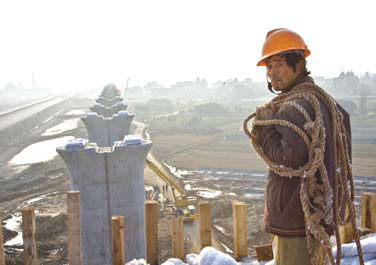Economy
Maglev runs into friction
By Qian Yanfeng (China Daily)
Updated: 2010-04-12 07:08
 |
Large Medium Small |
As Li Qingwei sat down to pen a letter of protest over the expansion of Shanghai's magnetic levitation (maglev) rail link, he had a strange sense of deja vu. He and thousands of others had fought, and won, this battle once before.
|
 |
|
This photo taken in January shows a worker at a section of the Shanghai-Hangzhou high speed railway construction site. The maglev will be far more expensive yet only 10 minutes faster than the high speed rail. LI PENG / FOR CHINA DAILY
|
Officials at the Ministry of Railways were tight-lipped on the stalled maglev project until last month when they announced the extension had won approval from the National Development and Reform Commission (NDRC), the nation's top economic planning body.
The news caused a stir among the millions of residents who live along the proposed route, which prompted authorities in both cities to insist there is no imminent timetable for construction as feasibility studies are still ongoing.
Yet builders at a construction site told Li some preliminary work has already been done. Several media organizations also reported that a parcel of land has been earmarked for a maglev station at the new terminal at Shanghai Hongqiao Airport.
"We wrote to the municipal government for confirmation on whether construction on part of the maglev line had already started at the expo site, but they only told a press conference there's no timetable for the project. They are not answering our question," said Li, 54, a former computer salesman.
The Shanghai-Hangzhou maglev link is one of many high-speed rail projects in the pipeline, with at least 10,000 km of track now under construction, according to Ministry of Railways figures.
In its latest rail development plan, the government is aiming for an 18,000-km network (including the Shanghai-Hangzhou maglev) by 2020.
However, although welcomed by rail experts and fueled largely by the State Council's 4-trillion-yuan ($586 billion) stimulus package, the expansion of high-speed travel has met some opposition.
In the past 12 months, there have been protests over the Guangzhou-Hong Kong and Shanghai-Hangzhou links (the latter opens in October and will run alongside the maglev), as well as complaints the newly opened Wuhan-Guangzhou service is too expensive for average customers.
Across the world, maglev is one of the more exciting yet controversial technologies being touted as the future of rail travel. With the use of sophisticated electromagnets, trains are suspended about 1 cm above a single rail to create a frictionless system.
Services between Shanghai Pudong International Airport and the city's Longyang Road station - the first commercially operated maglev link - travel at speeds of up to 431 km/h. The route, which in a car would take at least 45 minutes, takes the maglev just 8 minutes.
The extension project would take the line up to 200 km, starting at Pudong airport in the east, going through Hongqiao airport in the west, and then going on to Hangzhou. Travel between the two cities would take just 30 minutes, a third of the time it takes regular services.







